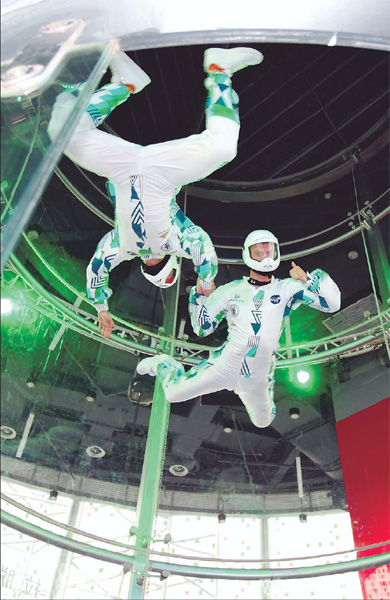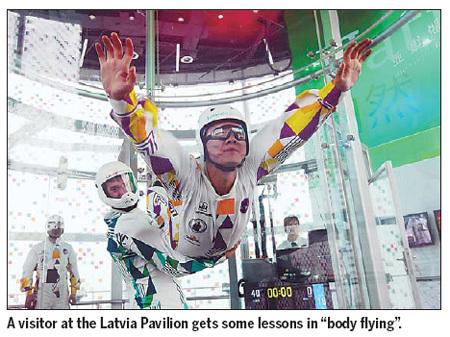
"Body fliers" do their stuff inside the Latvia Pavilion. gao erqiang / China daily |
Inside a room filled with giant cushions, a handful of young men lounge around in white Clockwork Orange boiler suits, most of them unbuttoned to the waist, toying with laptops as they wait for a battered walkie-talkie to call them into action.
After some garbled words come over the static of the walkie-talkie, one of the "body fliers" jumps up, slips on his sky-diving helmet and pierces his teammates with a steely gaze. "It's show time," says 30-year-old Ingus Augsdkalns, bursting into a self-deprecating grin.
The stage set, he walks up metal stairs and into an 8-meter vertical wind tunnel with a teammate. The music reeks of a subculture, all hip-hop and scratchy breaks. The wind-o-meter reads 40 percent, due to a small malfunction. It should say 25 percent.
Apart from this, all systems are GO.
Within seconds the two are break dancing in mid-air and drawing sighs from a crowd of 400 Chinese with the sheer virtuosity of their turns and sudden dives, which start from the roof of the tunnel and end within inches of the wire webbing that serves as its base.
Scenes like this play out daily at the Latvia Pavilion. The pavilion is 1,000 square meters in size and cost $6 million to build, putting it in the small and affordable bracket by Expo standards. Despite this, it serves as maybe the greatest one-trick pony within the sprawling Expo Garden.
Inside a coiling, snail-like exterior that catches the eye with its glittering multi-colored pixels on a silver base, main contractor Aerodium has commandeered control of the building with its central exhibit: a wind-tunnel that was pioneered by the military and later turned to recreational use by sky-diving operators.
The technology that lets you float in the air is hardly new, with Aerodium engineer Jean St-Germain proudly trumpeting it in National Geographic magazine back in 1982, three years after he built his first wind tunnel. What is different now is the application and, of course, the odd tweak or two.
Now, the masterminds at Aerodium hope to further commercialize body flying, an alternative experience that lets you snowboard, dance or practice kung fu at heights of up to 25 meters, either in a tunnel or in the open. The sport, or hobby, has taken off in Latvia in the past five years, where two 1-minute rides cost 200 yuan.
"Our technology is at the absolute cutting-edge of this industry and 100 percent made in Lativa," said spokesperson Janet Wang, adding that vertical wind tunnels cost from 1.5 million to 20 million yuan to build.
"When we opened our pavilion, we invited our (industrial) competitors to come and view our product. They were so impressed they told us they wanted to buy it, even though they said it jokingly."
Due to a paucity of press coverage and the neighboring Denmark Pavilion stealing much of the limelight, with its rent-a-bike scheme and The Little Mermaid statue, visitors to the Latvia Pavilion only need to queue an average of 20 minutes to watch a sensational show and win the chance to experience simulated skydiving.
The team performs every 30 minutes. It also invites guests to enter a lottery upon entering the pavilion. The winners, of whom there are about six an hour, get to fly with an instructor following basic video training and a quick medical check-up.


